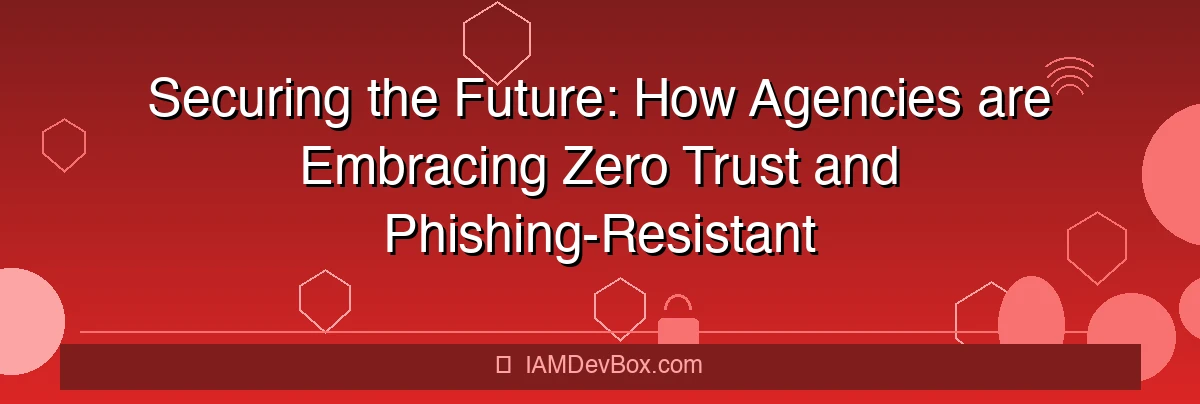Securing the Future: How Agencies are Embracing Zero Trust and Phishing-Resistant Authentication
Tag: Zero Trust Architecture, Phishing-Resistant Authentication, Cybersecurity, FIDO2, WebAuthn
Visual Overview:
graph TB
subgraph "Zero Trust Architecture"
User[User/Device] --> Verify{Identity Verification}
Verify --> MFA[Multi-Factor Auth]
MFA --> Context{Context Analysis}
Context --> Policy{Policy Engine}
Policy --> |Allow| Resource[Protected Resource]
Policy --> |Deny| Block[Access Denied]
Context --> Device[Device Trust]
Context --> Location[Location Check]
Context --> Behavior[Behavior Analysis]
end
style Verify fill:#667eea,color:#fff
style Policy fill:#764ba2,color:#fff
style Resource fill:#4caf50,color:#fff
style Block fill:#f44336,color:#fff
In the ever-evolving landscape of cybersecurity, agencies are increasingly adopting innovative strategies to safeguard sensitive information. The shift towards Zero Trust Architecture (ZTA) and phishing-resistant authentication methods is a pivotal step in this journey. This blog explores how these strategies are transforming security frameworks and offers insights into their implementation.
Introduction to Zero Trust Architecture
Zero Trust Architecture (ZTA) is a security model that mandates verification of identity for all users and devices attempting to access resources. Unlike traditional security models that trust users inside the network perimeter, ZTA operates on the principle of “never trust, always verify.” This approach is crucial in today’s distributed computing environment where threats can originate from anywhere.
Diagram: Zero Trust Architecture Components
[Network] -> [Verification Layer] -> [Access Control] -> [Resource]
This diagram illustrates the layers of verification and access control that ZTA employs, ensuring that only authorized entities gain access.
Phishing-Resistant Authentication: Modern Solutions
Traditional authentication methods, such as passwords, are vulnerable to phishing attacks. Agencies are turning to modern solutions like FIDO2 and WebAuthn, which offer robust, phishing-resistant alternatives.
FIDO2 and WebAuthn: A Technical Overview
FIDO2 (Fast Identity Online 2.0) and WebAuthn (Web Authentication) are standards that enable secure, passwordless authentication. These protocols use public-key cryptography to authenticate users, making them resistant to phishing attempts.
Code Example: Integrating FIDO2 into an Application
// Initialize the FIDO2 authenticator
const authenticator = new FIDO2Authenticator();
// Create a new credential
async function createCredential() {
const publicKey = await navigator.credentials.createPublicKey({
publicKey: {
challenge: new Uint8Array([...]),
rp: { id: 'example.com', name: 'Example' },
user: { id: new Uint8Array([...]), name: '[email protected]' },
algorithm: 'RSASSA-PKCS1-v1_5',
keyLength: 2048
}
});
return publicKey;
}
This code snippet demonstrates how to create a FIDO2 credential, highlighting the use of public-key cryptography for secure authentication.
Combin
The synergy between ZTA and phishing-resistant authentication creates a comprehensive security framework. ZTA ensures continuous verification, while phishing-resistant methods fortify the authentication process against attacks.
Real-World Case Study: U.S. Federal Government Implementation
The U.S. federal government has adopted ZTA and phishing-resistant authentication to secure its networks. By integrating FIDO2 with ZTA, they have significantly reduced the risk of unauthorized access and phishing incidents.
Diagram: Integrated Security Framework
[User] -> [Phishing-Resistant Auth] -> [Zero Trust Verification] -> [Secure Access]
This diagram showcases the seamless integration of authentication and verification layers, providing a robust security posture.
Extended Questions for Readers
- How can your organization assess its current security measures against Zero Trust principles?
- What steps can be taken to transition from traditional authentication methods to phishing-resistant solutions?
- How do you measure the effectiveness of your security framework after adopting new strategies?
Conclusion
The adoption of Zero Trust Architecture and phishing-resistant authentication by agencies marks a significant advancement in cybersecurity. By leveraging these strategies, organizations can build a resilient security framework that mitigates risks and adapts to evolving threats. The journey towards a secure future involves continuous learning and innovation, making now the right time to embrace these transformative approaches.
